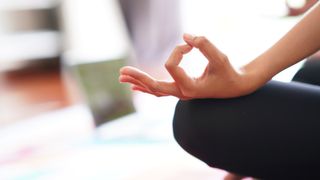How to breathe better—plus, breathing exercises to de-stress, relieve pain and help you sleep
Learning how to breathe better and using your lungs to their full potential can bring a whole host of benefits


You may not think you need to learn how to breathe better. After all, breathing is something we all do every minute of every day, without even thinking, right?
Yet despite inhaling and exhaling at least 17,000 times per day, which is more than six million times a year, many of us have lost our natural ability to breathe fully. That’s because, from an early age, we’re taught how to control our feelings and emotions and, as a result, our muscles tighten and our breathing patterns become restricted.
But learning how to breathe better can make such a difference. While breathing is essential for living, breathing correctly can have a hugely positive impact on your mental and physical health. It can boost everything from your respiratory system to your lymphatic system, as well as help calm nerves, and release muscle tension and toxins. “By changing the way you breathe, you can improve your physical health, plus your mental and emotional wellbeing,” says breath coach Stuart Sandeman, founder of Breathpod.
The best thing about harnessing the power of your breath, and using it as a tool for your health and wellbeing, is that it’s free. While it can be done on the move, you could also take time out each day and simply lie down on a yoga mat, and focus on your breath for five minutes. Here's why taking this time out to breathe is so important, plus the best breathing exercises to try right now.
How does breathing affect the body?
Although we’ve been doing it since the moment we were born, most of us aren’t inhaling properly. “A lot of people breathe into their chest muscles, rather than fully using their diaphragm, external intercostals, and the scalene muscles (in the neck) and relaxing their lower abdomen,” says breath expert Rebecca Dennis. This can worsen when we are stressed or anxious and our breathing can become shallow and rapid, which can sap our energy.
Common signs of breathing difficulty
"One in ten of us have symptoms of dysfunctional breathing,” says Stuart. Spotting that you’re not harnessing the potential of your lung power is easier than you think.
One or more of these symptoms can indicate you aren’t breathing correctly, says Dr Nerina Ramlakhan:
Sign up for the woman&home newsletter
Sign up to our free daily email for the latest royal and entertainment news, interesting opinion, expert advice on styling and beauty trends, and no-nonsense guides to the health and wellness questions you want answered.
- INTERMITTENT DEEP SIGHING
This is often caused by unconscious breath-holding as the body tries to make up for the oxygen deficit. - YAWNING MORE OFTEN THAN NORMAL
You need more oxygen. We take about five to eight breaths a minute when relaxed, but a shallow breather can take from ten to 20 breaths, most often from the chest. - GRINDING TEETH AT NIGHT
This is often accompanied by shallow breathing. Usually, both are signs of stress. - TIGHT NECK AND SHOULDERS
When you breathe only into your chest, the muscles in the neck, shoulders and back try to “chip in” and help the body breathe deeper so that the lungs get more air.

Benefits of breathing deeply
Knowing how to breathe better is essential as it can have a big impact on the mind and body. It can help you to release toxins, manage emotions, curb stress and even promote better digestion.
- RELEASE TOXINS
Deep breathing massages your body’s lymphatic system, which helps to eliminate waste and toxins. - MANAGE EMOTIONS
"Proper breathing can help us to tap into, control and release our emotions,” explains breathing expert Kirsty Gallagher, who works with Fitbit. When we stifle an emotion, we subconsciously hold our breath, which can make us feel even worse. “Learning how to breathe better is a great self-healer.” - CURB STRESS
Breathing slowly and deeply, which is used in the Wim hof breathing technique, can help keep your mind calm and alleviate stress and anxiety. - PROMOTE DIGESTION
Slower breathing activates the parasympathetic nervous system, which promotes a range of good effects, including better sleep and relaxation. “The parasympathetic system is triggered when you’re resting and is known as ‘rest and digest’,” says Kirsty, meaning it will also enhance digestion.

How to breathe better—improving your breathing naturally with breathing techniques
Before you learn how to breathe better, you need to go back to basics to make sure you’re getting the fundamentals right. “To ensure you’re breathing correctly on a day-to-day basis, check in with your breath throughout the day,” says Stuart. Make it your moment of mindfulness or incorporate it into your bedtime routine with a sleep guided meditation or yoga nidra practice.
Stuart recommends:
- BREATHE IN AND OUT THROUGH THE NOSE, NOT THE MOUTH
The nose is designed for breathing and, except for certain situations, such as high-intensity sport, your nose does a much better job of breathing than your mouth. - USE YOUR DIAPHRAGM, RATHER THAN YOUR CHEST
Ensure the belly rises before the chest. It makes you feel more centred and in control. It’s efficient and, once established, easy and natural. - BREATHE OUT MORE THAN IN
Exhaling is linked to the body’s relaxation response as it stimulates the parasympathetic branch of the autonomic nervous system. When we’re feeling stressed, a little more exhalation with every breath can help.
Best breathing technique for anxiety, panic or stress
When we’re stressed, our breathing quickens. The fast intake of air leads to a build-up of oxygen in the bloodstream, which puts the pH level of the blood off-kilter. This can result in muscle twitching, irritability, and anxiety. “Box breathing reduces your heart rate, causing your body and mind to relax,” says Stuart.
If you're a visual person, you can picture a box in your mind's eye as you practice this technique:
- Inhale through the nose for a count of four
- Hold the breath for a count of four
- Exhale through the nose for a count of four
- Hold the breath for a count of four
- Repeat four rounds
Best breathing technique for sleep
Not being able to sleep can encompass factors that range from emotional and environmental, to physiological and physical.
The best thing to do when you want to know how to fall asleep fast is to put your focus on something rhythmic like your breathing. This can help you to prime your body to feel relaxed and safe enough that you fall asleep without noticing.
“This maximizes the rest and digest (parasympathetic) response, and slows the mind and the system so that you can nod off to sleep,” says Stuart. Many sleep apps will use a similar breathing technique to help you get ready for sleep.
- Breath in for five
- Hold for five
- Breath out slowly for 10
Best breathing technique to help with pain
“Chronic pain can trigger your stress receptors in all areas of the body,” says Stuart. “Deep breaths allow more oxygen to the muscles, which loosen the fibers to relax.”
Try this easy breathing exercise:
- Inhale through the nose for a count of four
- Hold the breath for a count of six
- Exhale through pursed lips for a count of eight
- Repeat four rounds
How often should you do breathing exercises?
If you want to learn how to breathe better, the beauty of these exercises is they can be practiced almost anywhere, at any time. “Some can be done on the go, while others require a bit more stillness,” says Stuart.
Try to make time for some mindful breathing every day. “A daily morning practice is great to allow your day to start off in a calmer frame of mind,” says Aimee Hartley, author of Breathe Well. “Weaving in a short daily practice during the day is also beneficial, such as short breath practice on the way to work. You don’t need to always lie down and light candles to practice breathwork, you can simply practice on the move.”
Take your time, especially if it doesn’t feel natural at first. “If you’re looking to change a deeper-rooted habit or pattern, then changes can take a month or two of daily practice,” says Stuart.
Faye M Smith is an award-winning journalist with over 20 years experience in the magazine industry. Her continued work in the area of natural health won her the coveted title of the Health Food Manufacturers’ Association (HFMA) Journalist of the Year Award 2021. Currently Group Health Director across several magazines including woman&home, Woman, and Woman’s Own, Faye specialises in writing about women’s health, especially menopause, relationships and mental health.
-
 Shetland season 9 ending explained: Who murdered Annie and Bergen?
Shetland season 9 ending explained: Who murdered Annie and Bergen?We delve in the Shetland season 9 final episode to unpick everything happened, and find out who was responsible for the death of Annie and Bergen.
By Lucy Wigley Published
-
 Ageing expert reveals 4 tips to 'build better bone' on Davina McCall's new podcast - and why it's so important
Ageing expert reveals 4 tips to 'build better bone' on Davina McCall's new podcast - and why it's so importantDr Vonda Wright is a leading surgeon, scientist, and researcher on longevity and mobility
By Grace Walsh Published